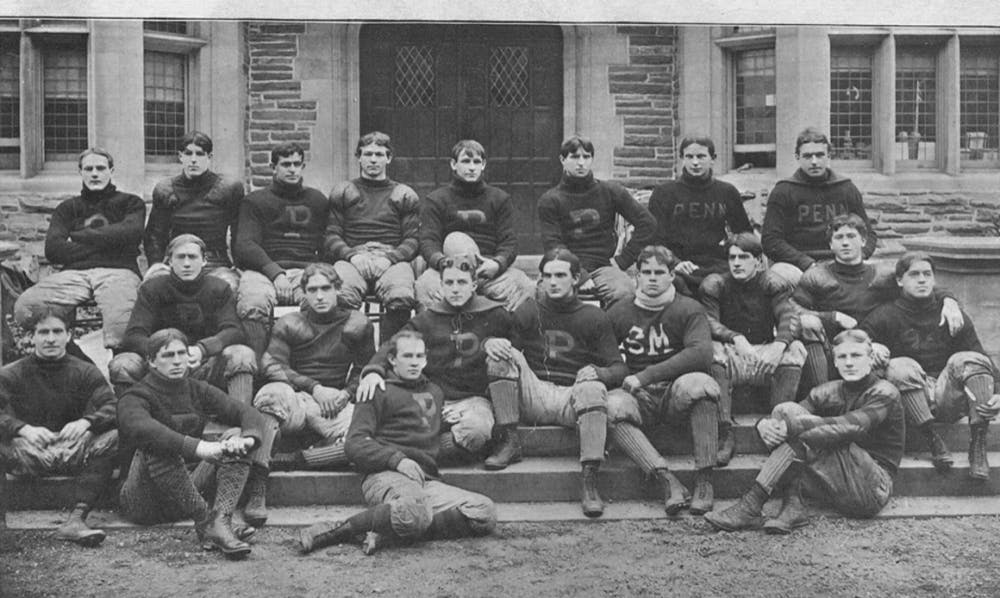Though often overshadowed by today’s football powerhouses, Penn has one of the most decorated football programs in history. Since 1876, the Quakers have won seven national championships, tallied 837 wins, and fielded 18 members of the College Football Hall of Fame. Teams led by Jerry Berndt, Al Bagnoli, and currently Ray Priore have strung together 15 conference championships within the last 40 years.
But if you’re looking to find the most dominant Penn football team, you’d have to travel back to the 19th century. The 1897 Penn Quakers were, until recently, the last college football team to go 15-0, and they still are one of only three teams to win 15 or more games in a single season.
American football was strikingly different in its origins. Field goals were worth five points, and touchdowns were worth just four. Teams sometimes had different rules, too.
Yale and Princeton alternated titles up until the 1890s, when Penn burst onto the scene. Led by coach George H. Woodruff, a law student, the Quakers posted a 124-15-2 record from 1892 to 1901 and won three national championships.
Woodruff’s most dominant season, though, was the 1897 campaign. This team featured College Football Hall-of-Famer John Outland on the offensive and defensive lines, where he was named an All-American. The Outland Trophy, given to the nation’s top interior lineman, is named in his honor. The Quakers also fielded Truxton “T.T.” Hare, who would go on to be a four-time All-American and an Olympic Silver Medalist.
In the first week of the season, the Quakers beat Bucknell 17-0, Franklin and Marshall 33-0, and Washington and Jefferson 18-4. The Pennsylvanian, as The Daily Pennsylvanian was called at the time, reported that “the Varsity team defeated the Franklin and Marshall eleven 33-0, on Saturday afternoon, in thirty-five minutes actual playing.”
The Quakers then proceeded to rattle off eight straight shutout wins, outscoring opponents 281-0. Their winning streak included dominant wins over future Ivy League rivals Brown and Dartmouth (the Ivy League was not created until 1954). Their 40-0 win over Brown on October 30 would have been bigger, but the second half was called when “it was impossible on account of darkness for the spectators to distinguish the men or for the men to see the hall at a greater distance than 10 or 12 yards,” per The Pennsylvanian.
At this point, Penn was easily undefeated, having outscored its opponents 402-4 over the course of 11 games. Still, the Red and Blue had their toughest games ahead of them. On November 6, they toppled the Carlisle Indian Industrial School, a now-defunct university that would feature football legend Jim Thorpe in the early 20th century. The game was the Quakers’ closest to date, with Penn coming out victorious by a score of 20-10.
RELATED:
Penn football blown out in season finale as Princeton claims outright Ivy title
Penn football's schedule for 2019 confirmed, featuring two new nonconference opponents
Penn dismantled Wesleyan the following week, but Harvard and Cornell stood in its path for a perfect season. Against the Crimson, the Red and Blue trailed 6-0 at halftime, but they came back thanks to a trick play. During the week, the Quakers practiced a fake field goal while reporters watched on. Out of halftime, Harvard was expecting a fake field goal, but Penn kicker Jack Minds drilled a field goal to give the Quakers life in the second half. A galvanized Red and Blue squad rolled the Crimson in the second half and finished with a 15-6 win.
All Penn needed now was a home victory over Cornell to finish its undefeated season. The game was scoreless throughout, but at the final whistle, Penn muscled its way into the end zone to finish off a 4-0 win and a perfect 15-0 season. They outscored their opponents 463-20 on the season, and the 1897 season marked the third national championship in four years for the Red and Blue.
Penn football was a true powerhouse in the 1890s. Even with Alabama and Clemson’s recurring appearances in the College Football Playoff, these teams could only wish to match the Quakers’ level of dominance.









